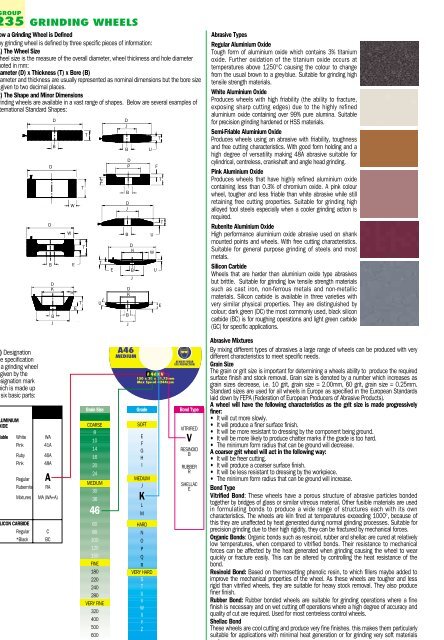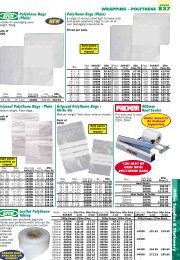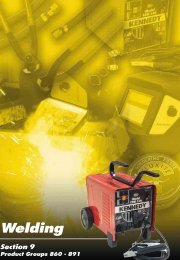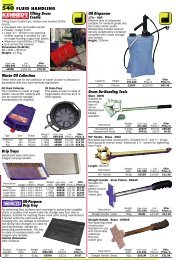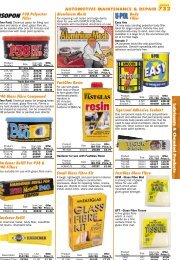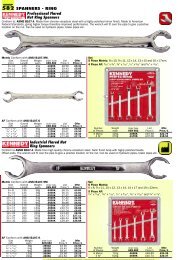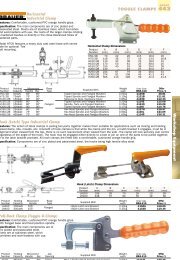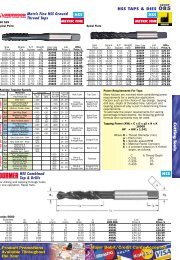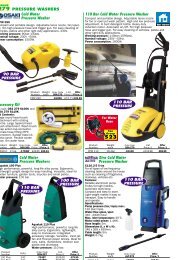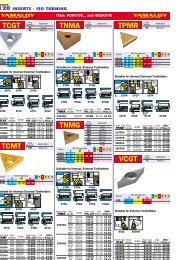CARBIDE BURRS Carbide Burrs Carbide Burrs ... - everpro.my
CARBIDE BURRS Carbide Burrs Carbide Burrs ... - everpro.my
CARBIDE BURRS Carbide Burrs Carbide Burrs ... - everpro.my
You also want an ePaper? Increase the reach of your titles
YUMPU automatically turns print PDFs into web optimized ePapers that Google loves.
GROUP<br />
235<br />
GRINDING WHEELS<br />
How a Grinding Wheel is Defined<br />
Any grinding wheel is defined by three specific pieces of information:<br />
(1) The Wheel Size<br />
Wheel size is the measure of the overall diameter, wheel thickness and hole diameter<br />
quoted in mm:<br />
Diameter (D) x Thickness (T) x Bore (B)<br />
Diameter and thickness are usually represented as nominal dimensions but the bore size<br />
is given to two decimal places.<br />
(2) The Shape and Minor Dimensions<br />
Grinding wheels are available in a vast range of shapes. Below are several examples of<br />
International Standard Shapes:<br />
D<br />
D<br />
B<br />
D<br />
B<br />
D<br />
K<br />
B<br />
J<br />
W<br />
W<br />
E<br />
W<br />
T<br />
T<br />
E<br />
T<br />
T<br />
T<br />
U<br />
E<br />
E<br />
D<br />
J<br />
B<br />
D<br />
P<br />
B<br />
D<br />
J<br />
B<br />
D<br />
K<br />
D<br />
K<br />
B<br />
J<br />
B<br />
J<br />
U<br />
U<br />
W<br />
F<br />
U<br />
T<br />
T<br />
E<br />
T<br />
Abrasive Types<br />
Regular Aluminium Oxide<br />
Tough form of aluminium oxide which contains 3% titanium<br />
oxide. Further oxidation of the titanium oxide occurs at<br />
temperatures above 1250°C causing the colour to change<br />
from the usual brown to a grey-blue. Suitable for grinding high<br />
tensile strength materials.<br />
White Aluminium Oxide<br />
Produces wheels with high friability (the ability to fracture,<br />
exposing sharp cutting edges) due to the highly refined<br />
aluminium oxide containing over 99% pure alumina. Suitable<br />
for precision grinding hardened or HSS materials.<br />
Semi-Friable Aluminium Oxide<br />
Produces wheels using an abrasive with friability, toughness<br />
and free cutting characteristics. With good form holding and a<br />
high degree of versatility making 48A abrasive suitable for<br />
cylindrical, centreless, crankshaft and angle head grinding.<br />
Pink Aluminium Oxide<br />
Produces wheels that have highly refined aluminium oxide<br />
containing less than 0.3% of chromium oxide. A pink colour<br />
wheel, tougher and less friable than white abrasive while still<br />
retaining free cutting properties. Suitable for grinding high<br />
alloyed tool steels especially when a cooler grinding action is<br />
required.<br />
Rubenite Aluminium Oxide<br />
High performance aluminium oxide abrasive used on shank<br />
mounted points and wheels. With free cutting characteristics.<br />
Suitable for general purpose grinding of steels and most<br />
metals.<br />
Silicon <strong>Carbide</strong><br />
Wheels that are harder than aluminium oxide type abrasives<br />
but brittle. Suitable for grinding low tensile strength materials<br />
such as cast iron, non-ferrous metals and non-metallic<br />
materials. Silicon carbide is available in three varieties with<br />
very similar physical properties. They are distinguished by<br />
colour; dark green (DC) the most commonly used, black silicon<br />
carbide (BC) is for roughing operations and light green carbide<br />
(GC) for specific applications.<br />
Abrasives & Power Tools<br />
(3) Designation<br />
The specification<br />
of a grinding wheel<br />
is given by the<br />
designation mark<br />
which is made up<br />
of six basic parts:<br />
ALUMINIUM<br />
OXIDE<br />
Friable White WA<br />
Pink 41A<br />
Ruby 46A<br />
Pink 48A<br />
Regular<br />
Rubernite<br />
Mixtures<br />
SILICON <strong>CARBIDE</strong><br />
Regular<br />
*Black<br />
Page360<br />
A<br />
RA<br />
MA (WA+A)<br />
C<br />
BC<br />
Grain Size<br />
COARSE<br />
8<br />
10<br />
14<br />
16<br />
20<br />
24<br />
MEDIUM<br />
30<br />
36<br />
46<br />
60<br />
80<br />
100<br />
120<br />
150<br />
FINE<br />
180<br />
220<br />
240<br />
280<br />
VERY FINE<br />
320<br />
400<br />
500<br />
600<br />
A46<br />
MEDIUM<br />
A46KV<br />
150 x 20 x 31.75mm<br />
Max Speed 4244rpm<br />
Grade<br />
SOFT<br />
E<br />
F<br />
G<br />
H<br />
I<br />
MEDIUM<br />
J<br />
K<br />
L<br />
M<br />
HARD<br />
N<br />
O<br />
P<br />
Q<br />
R<br />
VERY HARD<br />
S<br />
T<br />
U<br />
V<br />
W<br />
X<br />
Y<br />
Z<br />
ALWAYS WEAR<br />
EYE PROTECTION<br />
Bond Type<br />
VITRIFIED<br />
V<br />
RESINOID<br />
B<br />
RUBBER<br />
R<br />
SHELLAC<br />
E<br />
Abrasive Mixtures<br />
By mixing different types of abrasives a large range of wheels can be produced with very<br />
different characteristics to meet specific needs.<br />
Grain Size<br />
The grain or grit size is important for determining a wheels ability to produce the required<br />
surface finish and stock removal. Grain size is denoted by a number which increases as<br />
grain sizes decrease, i.e. 10 grit, grain size = 2.00mm, 60 grit, grain size = 0.25mm.<br />
Standard sizes are used for all wheels in Europe as specified in the European Standards<br />
laid down by FEPA (Federation of European Producers of Abrasive Products).<br />
A wheel will have the following characteristics as the grit size is made progressively<br />
finer:<br />
• It will cut more slowly.<br />
• It will produce a finer surface finish.<br />
• It will be more resistant to dressing by the component being ground.<br />
• It will be more likely to produce chatter marks if the grade is too hard.<br />
• The minimum form radius that can be ground will decrease.<br />
A coarser grit wheel will act in the following way:<br />
• It will be freer cutting.<br />
• It will produce a coarser surface finish.<br />
• It will be less resistant to dressing by the workpiece.<br />
• The minimum form radius that can be ground will increase.<br />
Bond Type<br />
Vitrified Bond: These wheels have a porous structure of abrasive particles bonded<br />
together by bridges of glass or similar vitreous material. Other fusible materials are used<br />
in formulating bonds to produce a wide range of structures each with its own<br />
characteristics. The wheels are kiln fired at temperatures exceeding 1000°, because of<br />
this they are unaffected by heat generated during normal grinding processes. Suitable for<br />
precision grinding due to their high rigidity, they can be fractured by mechanical forces.<br />
Organic Bonds: Organic bonds such as resinoid, rubber and shellac are cured at relatively<br />
low temperatures, when compared to vitrified bonds. Their resistance to mechanical<br />
forces can be affected by the heat generated when grinding causing the wheel to wear<br />
quickly or fracture easily. This can be altered by controlling the heat resistance of the<br />
bond.<br />
Resinoid Bond: Based on thermosetting phenolic resin, to which fillers maybe added to<br />
improve the mechanical properties of the wheel. As these wheels are tougher and less<br />
rigid than vitrified wheels, they are suitable for heavy stock removal. They also produce<br />
finer finish.<br />
Rubber Bond: Rubber bonded wheels are suitable for grinding operations where a fine<br />
finish is necessary and on wet cutting off operations where a high degree of accuracy and<br />
quality of cut are required. Used for most centreless control wheels.<br />
Shellac Bond<br />
These wheels are cool cutting and produce very fine finishes. this makes them particularly<br />
suitable for applications with minimal heat generation or for grinding very soft materials<br />
such as copper.<br />
CONTRACT PRICES AVAILABLE FOR VOLUME PURCHASES<br />
All Prices Exclude V.A.T. © 2009


